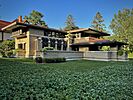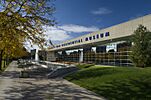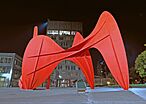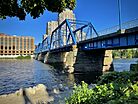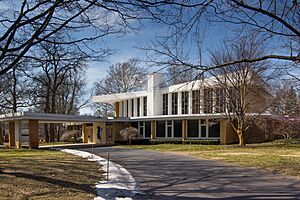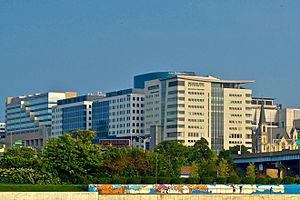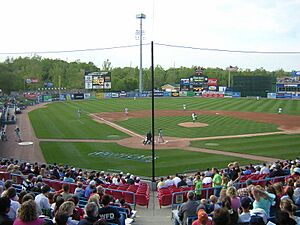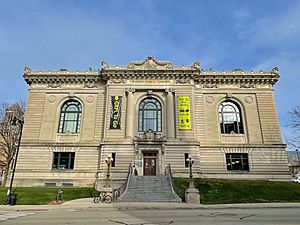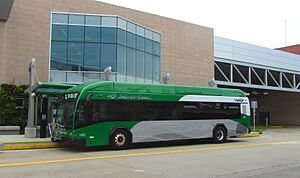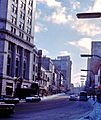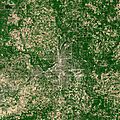Grand Rapids, Michigan facts for kids
Quick facts for kids
Grand Rapids
|
|||||
|---|---|---|---|---|---|
|
Downtown Grand Rapids
Van Andel Arena
Van Andel Institute
|
|||||
|
|||||
| Nicknames:
GR, Furniture City, Beer City USA
|
|||||
| Motto(s): | |||||
| Country | |||||
| State | |||||
| County | Kent | ||||
| Founded | 1826 | ||||
| Incorporated | 1838 (village) 1850 (city) |
||||
| Government | |||||
| • Type | City commission | ||||
| Area | |||||
| • City | 45.63 sq mi (118.19 km2) | ||||
| • Land | 44.78 sq mi (115.97 km2) | ||||
| • Water | 0.86 sq mi (2.22 km2) 1.92% | ||||
| Elevation | 640 ft (200 m) | ||||
| Population
(2020)
|
|||||
| • City | 198,893 | ||||
| • Rank | US: 115th MI: 2nd |
||||
| • Density | 4,442.49/sq mi (1,715.26/km2) | ||||
| • Urban | 605,666 (US: 70th) | ||||
| • Urban density | 2,207.6/sq mi (852.3/km2) | ||||
| • Metro | 1,162,950 (US: 49th) | ||||
| • CSA | 1,502,552 (US: 40th) | ||||
| Demonym(s) | Grand Rapidian | ||||
| Time zone | UTC−5 (EST) | ||||
| • Summer (DST) | UTC−4 (EDT) | ||||
| ZIP Codes |
49501–49508, 49510, 49514–49516, 49518, 49523, 49525, 49534, 49546, 49548, 49555, 49560, 49588, 49594
|
||||
| Area code(s) | 616 | ||||
| FIPS code | 26-34000 | ||||
| GNIS feature ID | 0627105 | ||||
Grand Rapids is a big city in Michigan, United States. It's the main city of Kent County. In 2020, nearly 200,000 people lived there. This makes it the second-largest city in Michigan, right after Detroit.
Grand Rapids is about 161 kilometers (100 miles) northwest of Detroit. It sits along the Grand River, about 40 kilometers (25 miles) east of Lake Michigan. It's a key center for business and culture in West Michigan.
The city has a long history of making furniture. Today, five of the world's top office furniture companies are here. That's why it's called "Furniture City." It's also known as "Beer City USA" because of its many craft breweries. Many local businesses use "River City" in their names because of the Grand River. The city's economy is diverse. It includes health care, information technology, car making, aviation, and making consumer goods.
Grand Rapids was the childhood home of U.S. President Gerald Ford. He and his wife, Betty Ford, are buried at the Gerald R. Ford Presidential Museum in the city. The Gerald R. Ford International Airport and a highway are named after him.
Contents
- History of Grand Rapids
- Grand Rapids Geography
- Grand Rapids Cityscape
- Grand Rapids Demographics
- Grand Rapids Economy
- Arts and Culture in Grand Rapids
- Sports in Grand Rapids
- Education in Grand Rapids
- Media in Grand Rapids
- Grand Rapids Transportation
- Sister Cities of Grand Rapids
- Images for kids
- See also
History of Grand Rapids
Grand Rapids has a rich history, from early Native American villages to a bustling modern city.
Early Settlements and Trading Posts
Native American Life by the Rapids
Long ago, Jesuit missionaries and traders explored Michigan. In 1806, Joseph La Framboise and his wife, Madeline, set up the first trading post in the area. It was on the Grand River, near today's Ada Township. They spoke French and likely Odawa, Madeline's native language.
Madeline La Framboise became a successful fur trader. She was known for her good reputation. By 1810, Chief Noonday, an Odawa chief, led a village called Bock-a-tinck. It was on the northwest side of what is now Grand Rapids. About 500 Odawa people lived there, sometimes more. Another village was led by Chief Black Skin, Chief Noonday's son.
First European Settlers Arrive
In 1823, a Baptist minister named Isaac McCoy came to the area. He wanted to start a mission. Later, in 1824, Reverend Leonard Slater arrived. Chief Noonday asked Slater to stay and build a mission. He believed it was the only way for the Odawa to remain in the area. Slater built the first settler buildings: a log cabin and a schoolhouse.
In 1826, Louis Campau built his own trading post. It was on the south bank of the Grand River. He traded goods with the Odawa and Ojibwa people. Campau is known as the official founder of Grand Rapids.
In 1833, Campau bought 291,000 square meters (72 acres) of land. He named it Grand Rapids. This area became the main downtown business district. More settlers arrived, and by 1835, about 50 people lived there. The first doctor, Dr. Wilson, came to the settlement.
Growing into a Village and City
By 1838, Grand Rapids became an official village. It covered about 0.75 square miles (1.9 square kilometers). People discovered gypsum near the Grand River. Mining began in 1841.
In 1845, the first official count showed 1,510 people. The city of Grand Rapids officially became a city on May 2, 1850. At that time, 2,686 people lived there. By 1857, the city grew to 10.5 square miles (27 square kilometers).
During the late 1800s, Grand Rapids became a major center for lumber. Logs floated down the Grand River to be cut into wood. The city also became famous for fine wood products. By the end of the century, it was known as the best furniture-making city in the United States. In 1880, the country's first hydro-electric generator was used here.
The Furniture City Era
Grand Rapids' Furniture Fame
Grand Rapids earned the nickname "Furniture City" because of its thriving furniture industry. Companies like William A. Berkey Company and Steelcase grew here. By 1911, about 8,500 people worked in 47 furniture factories. At least one-third of all workers in Grand Rapids were in the furniture business. This industry created many jobs for new immigrants from Europe.
Changes in the 20th Century
After World War II, many people moved to the suburbs. This caused downtown retail to decline. Department stores like Herpolsheimer's and Steketee's were once popular. But as people moved, these stores faced challenges.
By the 1960s, much of the furniture-making industry moved to North Carolina. Grand Rapids adapted by focusing on office furniture.
Grand Rapids Geography
Grand Rapids is located on the banks of the Grand River. The city was built where there were once rapids, which stopped ships from going further upstream. The river valley is flat and narrow, surrounded by hills. The area around the city has mixed forests and farms. It's especially known for its fruit orchards to the northwest.
Grand Rapids is about 40 kilometers (25 miles) east of Lake Michigan. The state capital, Lansing, is about 113 kilometers (70 miles) to the east. Kalamazoo is about 80 kilometers (50 miles) south.
The city is divided into four sections: NE (northeast), NW (northwest), SE (southeast), and SW (southwest). Fulton Street divides north and south, and Division Avenue divides east and west.
According to the United States Census Bureau, Grand Rapids covers about 117 square kilometers (45.27 square miles). Most of this is land, with a small amount of water.
Grand Rapids Climate and Weather
Grand Rapids has a humid continental climate. This means it has warm, humid summers and cold, snowy winters. Spring and autumn are short and mild.
Because it's east of Lake Michigan, the city gets some special weather. This includes many cloudy days in late fall and winter. Temperatures change more slowly in spring and fall. Winters are a bit milder, and there's a lot of lake effect snow. The city gets about 192 centimeters (75.6 inches) of snow each year. This makes it one of the snowiest major cities in the U.S.
The average temperature in Grand Rapids is about 9 degrees Celsius (49 degrees Fahrenheit). The highest temperature ever recorded was 42 degrees Celsius (108 degrees Fahrenheit) in 1936. The lowest was -31 degrees Celsius (-24 degrees Fahrenheit) in 1899.
Grand Rapids has faced floods because the Grand River flows through it. In 1904, a major flood put half the west side of the city underwater. More recently, in 2013, another flood caused thousands to leave their homes.
Grand Rapids Cityscape
The city's skyline features the Amway Grand Plaza Hotel. This hotel was once called the Pantlind. It reopened in 1981 after big changes. It has a 29-story glass tower with great views.
Another important building is the JW Marriott Grand Rapids. It's the first JW Marriott Hotel in the Midwest. Its design is inspired by Grand Rapids' sister cities. These include Omihachiman, Japan, and Bielsko-Biała, Poland.
The tallest building in Grand Rapids is the River House Condominiums. It's a 34-story tower finished in 2008. It's the tallest residential building in Michigan.
Grand Rapids also has two large urban nature centers. The Calvin Ecosystem Preserve and Native Gardens is 42 hectares (104 acres). It has nature trails and a wildlife preserve. The Blandford Nature Center is 107 hectares (264 acres). It has trails, an animal hospital, and a "heritage village" with old buildings. Blandford is one of the largest urban nature centers in the U.S.
Grand Rapids Demographics
Grand Rapids is a diverse city. In 2020, the population was 198,917.
Population Makeup
According to the 2020 census:
- About 57.46% of residents were White (not Hispanic).
- About 18.35% were Black or African American (not Hispanic).
- About 16.49% were Hispanic or Latino (of any race).
- Other groups include Asian, Native American, and people of two or more races.
In recent years, the Latino community in Grand Rapids has grown. However, the African American population has seen a decline. This is due to factors like rising rents and people moving to nearby suburbs.
Religious Life in Grand Rapids
Grand Rapids is home to many different religious groups. The Christian Reformed Church in North America has its main offices here.
Temple Emanuel, a Reform Judaism congregation, was founded in 1857. It is one of the oldest Reform congregations in the United States.
The Roman Catholic Diocese of Grand Rapids was created in 1882. It serves many Catholics in West Michigan. It has over 100 parishes and five high schools.
Other Christian groups, like the Reformed Church in America and the Protestant Reformed Churches in America, also have a strong presence. In 2022, The Church of Jesus Christ of Latter-day Saints announced plans to build a temple in Grand Rapids.
Grand Rapids Economy
Grand Rapids has a strong and varied economy.
Corewell Health (formerly Spectrum Health) is the largest employer in West Michigan. It has over 60,000 staff members. Many of its facilities are on the Grand Rapids Medical Mile. This area has world-class health science centers. These include the Van Andel Research Institute and Michigan State University College of Human Medicine's medical school. These facilities have attracted many health science businesses.
Grand Rapids is famous for making furniture. Companies like Steelcase, Haworth, and Herman Miller are based here. These companies make office furniture. The city is also known for its automobile and aviation manufacturing.
Many well-known companies are in the Grand Rapids area. These include Alticor/Amway, Bissell (vacuum cleaners), and Meijer (a regional grocery chain). Wolverine World Wide designs shoes and clothing here.
The city is also a center for Christian publishing. Companies like Zondervan and Eerdmans Publishing are located here.
Grand Rapids has a successful food processing and farming industry. The Grand Rapids Downtown Market helps with food education and supports new food businesses. Michigan is very diverse in agriculture. The Grand Rapids area is known for growing apples, peaches, and blueberries.
Arts and Culture in Grand Rapids
Grand Rapids is a vibrant city with many cultural attractions.
In 1969, a large sculpture called La Grande Vitesse was placed downtown. It means "the great swiftness" in French, referring to the rapids. This was the first public art in the U.S. funded by the National Endowment for the Arts. The sculpture is often called "the Calder." An annual Festival of the Arts is held around it. This festival has free live performances, food, and art. It's known as the largest all-volunteer arts festival in the U.S.
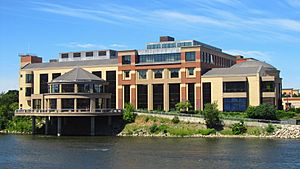
The Grand Rapids Public Museum is one of the oldest history museums in the United States. It was founded in 1854. Its main building is on the Grand River. It also includes the Roger B. Chaffee Planetarium.
ArtPrize is the world's largest art competition decided by public votes. It started in Grand Rapids in 2009. Artists from all over the world show their work. Visitors vote for their favorites.
Tourism and Attractions
Grand Rapids has many places to visit. The John Ball Zoological Garden is a popular zoo. The Gerald R. Ford Museum is also a key attraction. President Ford and his wife, Betty Ford, are buried there.
Other important downtown buildings include the DeVos Place Convention Center and the Van Andel Arena. The Urban Institute for Contemporary Arts has art exhibits and a movie theater.
Along the Grand River, you can see reconstructed burial mounds from the ancient Hopewell tribe. There's also a fish ladder and a riverwalk.

Heritage Hill is a historic neighborhood east of downtown. It has over 1,300 homes built from 1848. They show more than 60 different architectural styles. The Meyer May House is a famous home designed by Frank Lloyd Wright in 1908.
Grand Rapids is also known for its craft beer. It has been named the nation's "Best Beer City" several times. This makes it a popular spot for tourists.
Entertainment and Performing Arts
Grand Rapids has many places for concerts and shows. These include 20 Monroe Live, the Intersection, and Van Andel Arena. The Grand Rapids Symphony, founded in 1930, is the city's largest performing arts group. It performs over 400 shows a year.
The Grand Rapids Barbershop Chapter Great Lakes Chorus is an all-male singing group. They won the first International Chorus Competition in 1953.
The city has many theaters. The Meijer Majestic Theatre is the largest. The historic Wealthy Theatre is also popular. The Acrisure Amphitheater, a new outdoor venue, is planned to open in 2026.
The Grand Rapids Ballet Company started in 1971. It is one of Michigan's few professional ballet companies. Opera Grand Rapids, founded in 1966, is the state's longest-running professional opera company.
Sports in Grand Rapids
Grand Rapids is home to several professional and semi-professional sports teams.
- The West Michigan Whitecaps play baseball in the Midwest League. They have won the Championship Series six times. They are connected to the Detroit Tigers.
- The Grand Rapids Griffins are an ice hockey team in the American Hockey League. They play at the Van Andel Arena. They won the Calder Cup in 2013 and 2017. They are connected to the Detroit Red Wings.
- The Grand Rapids Gold is a basketball team in the NBA G League. They also play at the Van Andel Arena. They are connected to the Denver Nuggets.
- The Grand Rapids Rise is a professional women's indoor volleyball team. They play at the Van Andel Arena.
The Amway River Bank Run is an annual race held downtown. It attracts over 22,000 participants. The Grand Rapids Marathon is also held in the city.
Education in Grand Rapids
Grand Rapids offers many educational opportunities, from schools to universities.
Public schools are managed by Grand Rapids Public Schools (GRPS). There are also many charter schools. City High-Middle School is a special school for talented students. Catholic Central High School is the oldest co-educational Catholic high school in the U.S.
Grand Rapids has several colleges and universities:
- Aquinas College
- Calvin University
- Cornerstone University
- Grace Christian University
- Kuyper College
There are also seminaries for religious studies. Thomas M. Cooley Law School has a campus here. Davenport University has its main campus just outside Grand Rapids.
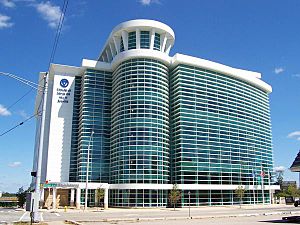
Grand Rapids Community College (GRCC) has a downtown campus. Grand Valley State University has a growing campus downtown, called the Pew Campus. It has expanded its medical programs on the Medical Mile.
Ferris State University has a campus downtown. It includes the Kendall College of Art and Design. Western Michigan University also has graduate programs here. The Van Andel Institute, a cancer research center, has a graduate school for Ph.D. students.
The Secchia Center is a large medical education building. It is home to the Grand Rapids Campus of the Michigan State University College of Human Medicine. This campus trains medical students.
Media in Grand Rapids
Grand Rapids has several news and entertainment outlets.
The Grand Rapids Press is the daily newspaper. Advance Newspapers publishes weekly community papers. Gemini Media publishes the Grand Rapids Business Journal and magazines like Grand Rapids Magazine. El Vocero Hispano is the largest Spanish language newspaper in West Michigan.
Grand Rapids is part of a large television market. Major TV networks have stations here, including NBC, ABC, Fox, and CBS. WGVU-TV is the local PBS station. The area also has many AM and FM radio stations.
Grand Rapids Transportation
Grand Rapids has various ways to get around.
Air Travel
Gerald R. Ford International Airport (GRR) provides commercial flights. It has over 150 daily flights to 34 nonstop destinations. Grand Rapids was one of the first cities in the U.S. to have regular passenger airline service, starting in 1926.
Major Roads
Several major highways serve Grand Rapids:
- I-96 runs north and northeast of the city.
- I-196, also called the Gerald R. Ford Freeway, goes east-west through the city.
- US-131 runs north-south through the city.
- M-6 is the Paul B. Henry Freeway on the south side.
- Other state highways like M-11, M-21, M-37, M-44, and M-45 also serve the area.
Public Transportation
The Rapid provides public bus transportation. The DASH buses offer free rides downtown. They connect parking lots to key spots in the city. The Greyhound Bus terminal is part of the Central Station, making transfers easy.
In 2014, the SilverLine opened. It's Michigan's first bus rapid transit line. It works like a light rail system. There are plans to add more express routes and a streetcar.
Train Service
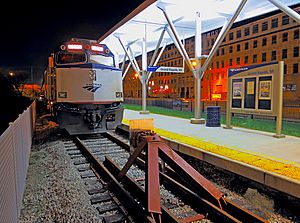
Amtrak offers direct train service to Chicago from the Grand Rapids station. This is via the Pere Marquette line. Freight train services are also available.
Sister Cities of Grand Rapids
Grand Rapids has several sister cities around the world:
 Bielsko-Biała, Poland
Bielsko-Biała, Poland Ga East and West District, Ghana
Ga East and West District, Ghana Gangnam-gu, South Korea
Gangnam-gu, South Korea Ōmihachiman, Japan
Ōmihachiman, Japan Perugia, Italy
Perugia, Italy Zapopan, Mexico
Zapopan, Mexico
Images for kids
-
Monroe Center in January 1965, with Sears, S. S. Kresge Company, Steketee's and Wurzburg's visible
-
2016 Independence Day celebration on the Grand River
See also
 In Spanish: Grand Rapids (Míchigan) para niños
In Spanish: Grand Rapids (Míchigan) para niños



